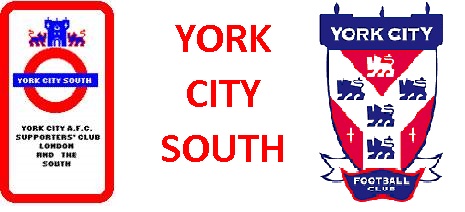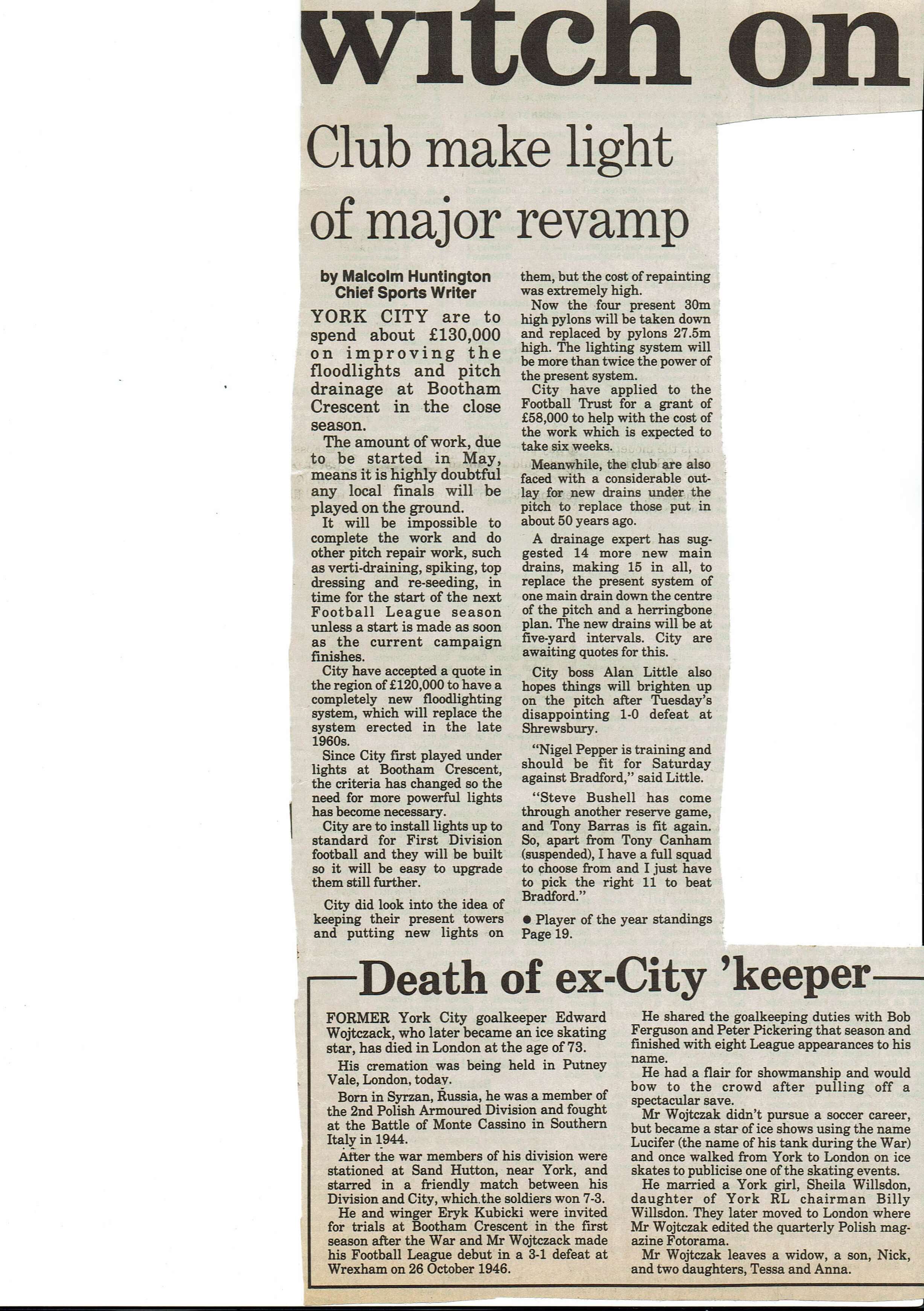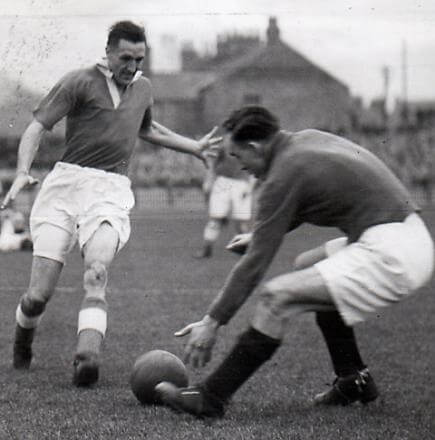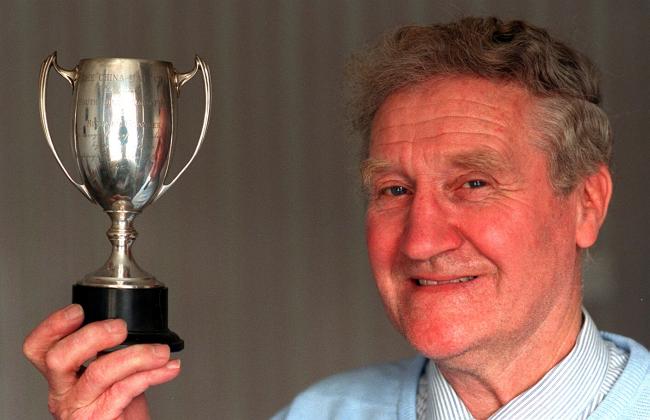

York City's Keepers: 1946-70
Bob Ferguson who had played in City's last 3 games before World War 2 was in goal when The Football League resumed in 1946. He made a further 26 City appearances that season. He lost his place to Edward Wojtczak, one of 2 former Polish prisoners of war to play for City that season and then to Peter Pickering. He played all but one of the games the following season before his £6,750 transfer to Chelsea (one Chelsea site quotes £20,000). Born in New Earswick, Pickering progressed through local football and made his debut as a 21 year old. His first 5 appearances in goal saw 5 wins. During the 1946/7 season, both Bob Ferguson (Rochdale (A), 07/September/46) and Peter Pickering (Accrington (A), 14/May/1947) saved 2 penalties in a game. Pickering saved 7 penalties during the 1947/8 season. He didn't make the grade at Chelsea but later played for Kettering and Northampton. He also played county cricket for Northamptonshire before emigrating to South Africa. Peter Pickering - Read More

John Frost was City's next keeper, originally from the north east, he made 45 appearances over 4 seasons, he started the 1948/9 season as first choice but lost his place and could never again establish himself as the number one. The early post war years also saw Joe Ashley make 9 appearances, Jeff Pears (later to spend over 50 years working at Terry's where he rose to the lofty position of Chairman's Chauffeur) and Alec Grant (all 1-1 draws) 3 each, and the former Manchester United and Torquay keeper, James Pegg one appearance, a 7-2 defeat on the opening day of the 1950/1 season. He was dropped after his debut and never played for City again.
Another north easterner, Matt Middleton followed Frost. Making his City debut at the age of 40, he played 55 games, the last being at New Brighton when he was 42 years and 194 days old, decoming the oldest player ever to play for City until Paul Musselwhite set a new record over 60 years later. From a goalkeeping family, Matt's younger brother, Ray, was an England B international. Middleton was in goal when City conceded at least one goal in each of 29 games during the 1948/9 and 1949/50 seasons, a club record.
The first 5 post war seasons had seen City struggle in the bottom half of Division 3 North. The arrival of Des Thompson, signed from non league football in January 1951, saw City's fortunes improve. Thompson quickly made his mark at Bootham Crescent. In under 2 years, he established himself as City's finest keeper to date. In November 1952, he was transferred to Burnley, at the time a leading Division 1 side, for £7,350, a record fee for a City keeper that stood until the sales of Nick Culkin and then Dean Kiely broke it in the mid 1990s. Thompson also played top flight football for Sheffield United but couldn't establish himself as either club's first choice.
Incidentally, Thompson once kept goal for City against Scunthorpe who had his elder brother, George, in goal. Watching from The Main Stand was their father, also called George Thompson who had kept goal for City when they were a Midland League side, before joining Southampton. Des Thompson was ousted as Burnley keeper, Colin McDonald who went on to make his England debut in 1958.
City signed Harold Searson from Leeds as a replacement for Thompson. He proved a capable replacement, although his claim to fame is probably the fact that he played League football on his wedding day. Its not recorded whether or not he kept a clean sheet that day. George Maddison, signed from Aldershot deputised on 11 occasions for Searson, his first win being on the last day of the season, his last game for York City.

In 1954, City slumped to 22nd position. During the side, a major team re-building exercise was undertaken. Little did anyone realise at the time what a transformation the new signings would make. 7 new players were signed, including Tommy Forgan. He was to spend 12 seasons at the club, starring for City in many memorable games, not least of which were those in the 1954/5 FA Cup run. Before joining City he had spent 5 seasons at Hull where he was the understudy to the legendary Billy Bly.
From the start, Forgan proved to be a popular signing. His form pushing City into the promotion picture. Injury caused him to miss the first 2 FA Cup games that season. Mick Granger proved a more than able deputy. Forgan returned in time for the game at Blackpool in Round 3. He was one of many heroes that afternoon, saving a penalty, as City stunned the footballing world to win 2-0 against a side containing the likes of Stanley Matthews, Stan Mortensen, Ernie Taylor and Harry Johnston. Forgan earned rave reviews as City progressed to the semi finals. Forgan was an ever present in the 1958/9 season as City gained promotion for the first time in their history. The following season (1959/60), Forgan missed many early season games through injury. City's form slumped and they were relegated after one season in the new Division 3. Forgan was still City's regular keeper as they gained promotion for the second time in their history in 1965.

Remarkably, in the 8 seasons between 1954 and 1962, City used only 2 keepers. Besides Forgan, only Mick Granger filled in between the posts. Granger had made his City debut in a 1952 FA Cup tie, but National Service commitments delayed his League debut, a 5-4 win at Carlisle, until November 1954. He was to make only 71 appearances over the next 8 seasons (including City's post war record defeat, 9-2 at Chester in 1958) before joining Hull and then Halifax. A former 'Footballer Of The Year' in his Hong Kong army days, during his City career, he was our number 2 but probably also Division 3's number 2 keeper, but he stayed loyal to his local club for 10 years rather than seek fame and first team football elsewhere. Mick Granger - Read More
Granger was the oldest ex City keeper present at The York City Supporters Trust launch meeting.
The Forgan / Granger era coincided with Sam Bartram's years as manager. The former City war time keeper was a popular choice when he was appointed in March 1956. He saw City promoted to Division 3 in 1959 but relegated a season later. He was reluctantly released by City in July 1960 when offered the manager's job at Luton who had just been relegated from Division 1. He had 2 seasons at Luton before becoming involved in sports journalism, for many years working on The Sunday People.
Sam Bartram was the first manager to lead City to promotion. He was also the first manager to see City relegated and probably the only City keeper to have a status cast in his honour, it was to mark Charlton's centenary in 2005. Around the same time, Sam Bartram Close was named in his honour outside The Valley. Mike Blake’s “Sam Bartram: The Story of a Goalkeeping Legend” is a must for anyone who to wants to know more about Sam and his career.
In 1963, Mick Granger scored an FA Cup goal for Halifax as an outfield players in a 4-1 defeat against Workington. Starting the game in goal, he moved outfield when he sustained an injury and in the pre substitute days, he hobbled along the touch line adding nuisance value rather than leave Halifax with just 10 men.
The early 1960s saw several pretenders for the number one jersey. Tony Moor spent 3 years in battle with Forgan, making just 57 appearances before joining Darlington where he played 239 games and then non league Scarborough. A good cricketeer, he played in the Yorkshire League for his native Scarborough until the 1980s. A St John's college student, Ian Wolstenholme played twice in goal for City in April 1964. Later he had a long and successful career in amateur football in the south east, both as a player and manager. The 1964/5 promotion season saw Tony Moor start in goal. A dreadful mistake in an FA Cup tie saw him lose his place, never to regain it. Tommy Forgan was restored to the side that was to gain promotion 4 months later.
Approaching 36, Tommy Forgan struggled slightly in Division 3. He broke a hand in a 5-1 home defeat by Bristol Rovers. Harry Fallon was quickly signed from St Johnstone. A former junior international keeper, he starred in several games, but equally, was prone to mistakes. He kept his place when Tommy Forgan recovered from injury but couldn't prevent a quick return to the basement division. Relegation meant a clear out, Tommy Forgan and the other surviving member of the 1955 FA Cup side, Norman Wilkinson left the club. Both players were presented with a gold watch by chairman Mr Hugh Kitchin who praised their loyalty and "true sportsmanship". Forgan later played for Gainsborough whilst working as a bricklayer before emigrating to Australia.
A dark, new era had begun. 3 successive re-election campaigns followed. A new keeper was signed, the highly promising Mike Walker from Shrewsbury. Walker was to earn 4 Welsh Under 23 caps but was prevented from adding full international honours to his name by Gary Sprake. Fallon started the 1966/7 season in goal. Walker made 20 appearances during the season, including 8 successive defeats just before Christmas. He established himself as our number one choice during 1967/8 season and in September 1968 moved to Watford for a small fee.
Mike Walker lost his place in the Watford goal to Pat Jennings. He then 451 league appearances for Colchester. As Colchester's manager, he was sacked in controversial circumstances, days after he had won a 'Manager Of The Month' award with Colchester flying high in Division 4. He's also remembered as the silver haired manager of other various clubs, including Norwich and Everton. His son, Ian, kept goal for England.
Mike Walker spent almost 5 years at Watford before moving onto Colchester where he made He moved to Norwich where he was promoted to manager. He moved to Everton in January 1994. He son, Ian, is continuiing the family goalkeeping tradition at Spurs.
The 1968/9 season saw City use 4 different keepers. Bob "Spider" Widdowson started the season in goal. Mike Walker (3 games) and Roy Tunks (4 games) deputised before local amateur John Andrews assumed the goalkeeping jersey for the last 11 games of the season when Widdowson was injured.
4 keepers were used during the following season. Only Widdowson spanned the 2 seasons, he made just 2 appearances. Mike Gadsby started the season as regular but lost his place to Gordon Morritt who was to make 28 appearances that season. Towards the end of the season, Ron Hillyard, a 17 year old keeper who had joined City after playing for Leeds United's intermediate made his debut. The season saw City finish in a respectable mid season position after 3 successive re-election seasons. By the end of the season, the defence had a solid look about it. John Mackin and Phil Burrows at full back, Barry Swallow and Chris Topping at centre back.
In terms of longevity, Ron Hillyard, believed to be the originator of the 70s footballer curly perm, was the most successful keeper after leaving City. He made a club record 563 league appearances for Gillingham before retiring in 1991, just short of 40. He was later on their staff and in early 2005 was last reported to be goalkeeping coach at Gravesend And Northfleet, although if his perm looked ridiculous at City, it was even more so as a 50+ year old Gravesend goalkeeping coach.
York City Keepers - Intro
York City Keepers – 1929 - 39
York City Keepers - World War 2
York City Keepers – 1946 - 1970
York City Keepers – 1970 - 1994
York City Keepers – 1994 - To Date
York City Keepers – City’s Long Serving Keepers
York City Keepers – With Long Careers
York City Keepers - The Best - Numbers